October 2017
Cereal Cyst Nematodes: A Complex and Destructive Group of Heterodera Species
View Article
In this month’s Feature article, Smiley and colleagues provide an in-depth review of cereal cyst nematodes, Heterodera spp., which cause substantial losses in small grain cereal production throughout the world. Some species are geographically isolated from others, and this has important implications for quarantine regulations. The authors discuss key species and their identifying characteristics, as well as the general life cycle of cereal cyst nematodes and management practices that can help reduce losses to these pests.
Evidence for a Novel Phylotype of Pseudomonas syringae Causing Bacterial Leaf Blight of Cantaloupe in China
Tian et al. compared strains of Pseudomonas syringae pv. lachrymans recovered from cantaloupe with those recovered from cucumber after obtaining negative PCR amplification data. Phylogeny of multilocus sequencing analysis revealed that P. syringae strains clustered based on the host from which they were recovered, and catabolic profiling and virulence testing of the strains supported these data. The authors concluded that P. syringae pv. lachrymans strains recovered from cantaloupe represent a novel phylotype.
September 2017
Interaction of Onion Cultivar and Growth Stage on Incidence of Pantoea ananatis Bulb Infection
View Article
Center rot of onion, caused by Pantoea ananatis, can cause a 100% crop loss if conditions are favorable for disease development. Center rot begins as lesions on onion leaves and may lead to bulb rot. Stumpf et al. proposed that bulbs might be more susceptible to rot if leaf infection occurred at different growth stages, and to test this theory, they inoculated five cultivars with P. ananatis at three growth stages. The authors found that cultivars varied in susceptibility to bulb infection and that a significantly higher incidence of center rot was observed for bulbs inoculated during the first leaf senescence stage compared with later stages.
July 2017
Timing Fungicide Application Intervals Based on Airborne Erysiphe necator Concentrations
View Article
Fungicides are commonly used to manage plant diseases. In many crops, fungicide applications are calendar-based programs or based on disease-forecasting models. To a lesser extent, inoculum detection has also been used. In this month’s issue of Plant Disease, Thiessen and colleagues report on timing fungicide applications to manage grape powdery mildew based on detection of Erysiphe necator spores in samplers placed in Oregon vineyards. Using this method, growers effectively managed the disease with approximately two fewer applications of fungicide compared with their standard management practice.
June 2017
Early Detection of Ganoderma Basal Stem Rot of Oil Palms Using Artificial Neural Network Spectral Analysis
View Article
Using image data to detect plant disease—particularly early, asymptomatic infections—is a fast-growing field of research. In this month’s issue, Ahmadi et al. report on analyzing hyperspectral data using the artificial neural network (ANN) technique to successfully detect different levels of infection of palms by Ganoderma boninense, the causal agent of basal stem rot of oil palm. The green wavelength was most successful at detecting early infections of G. boninense. Moreover, spectral signatures from frond 9 were very discriminatory and at 550–560 nm were able to distinguish plants with early infections from healthy plants.
May 2017
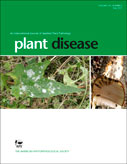 Lolium Pathotype of Magnaporthe oryzae Recovered from a Single Blasted Wheat Plant in the United States
Lolium Pathotype of Magnaporthe oryzae Recovered from a Single Blasted Wheat Plant in the United States
View Article
Wheat blast is an economically important disease in South America and on the “watch list” of North American wheat pathologists. In 2011, a single wheat plant with symptoms of wheat blast was found in Kentucky. Farman et al. recovered Magnaporthe oryzae from the diseased wheat head and used genome sequencing to show that the isolate was likely an endemic isolate that had “jumped host” from perennial ryegrass. Farman et al. also analyzed weather data and found that conditions during 2011 were favorable for early production of blast inoculum.
April 2017
 Genetic Variation in Native Populations of the Laurel Wilt Pathogen, Raffaelea lauricola, in Taiwan and Japan and the Introduced Population in the United States
Genetic Variation in Native Populations of the Laurel Wilt Pathogen, Raffaelea lauricola, in Taiwan and Japan and the Introduced Population in the United States
View Article
Wuest and colleagues compared the genetic diversity of Raffaelea lauricola populations from the United States, Japan, and Taiwan to test the hypothesis that the presence of the pathogen in the United States was the result of a single introduction. The population of R. lauricola in the United States was genetically uniform, with only one mating type detected; however, in isolates from Japan and Taiwan, two mating types of the pathogen and high genetic diversity were detected. These data support the single-introduction hypothesis.
March 2017
Virulence and Stump Colonization Ability of Armillaria Species on Norway Spruce Seedlings
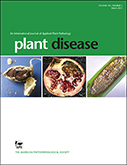 View Article
View Article
Armillaria root rot is caused by numerous species of Armillaria. Previous work has suggested that one species, A. borealis, which is often associated with diseased trees, acts more as a secondary pathogen, or saprophyte. Heinzelmann et al. compared the virulence of A. borealis, A. ostoyae, and A. cepistipes on seedlings of Norway spruce. Their data show that A. borealis has a clear pathogenic potential toward the seedlings. However, compared with A. ostoyae, the damage caused by A. borealis may decrease more rapidly with increasing tree age.
February 2017
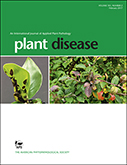 Evaluation of Ralstonia solanacearum Infection Dynamics in Resistant and Susceptible Pepper Lines Using Bioluminescence Imaging
Evaluation of Ralstonia solanacearum Infection Dynamics in Resistant and Susceptible Pepper Lines Using Bioluminescence Imaging
View Article
Screening for disease resistance is based on symptom expression and may not consider the latent infection of a pathogen in its host. Du et al. used bioluminescence imaging to track the colonization of pepper plants by Ralstonia solanacearum. Using this technology allowed the authors to visualize and compare R. solanacearum infection dynamics between resistant and susceptible pepper lines and consequently improved their understanding of resistance mechanisms in pepper to the bacterium. Bioluminescence imaging could also be used to detect latent infections in asymptomatic plants when evaluating pepper lines for resistance.
January 2017
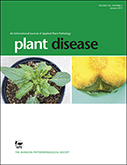 Strain-Specific Resistance to Potato virus Y (PVY) in Potato and Its Effect on the Relative Abundance of PVY Strains in Commercial Potato Fields
Strain-Specific Resistance to Potato virus Y (PVY) in Potato and Its Effect on the Relative Abundance of PVY Strains in Commercial Potato Fields
View Article
Recombinant strains of Potato virus Y (PVY) threaten potato production in the United States, and various reasons have been proposed for the increasing prevalence of recombinant strains of PVY. In this study, Funke et al. document a rapid PVY strain composition shift over 5 years in the Columbia Basin production area, from predominantly nonrecombinant PVYO to largely recombinant strains. The authors suggest that this shift may have been caused by selection pressure from strain-specific resistance genes in the potato cultivars being grown in the region.
December 2016
 Paraphoma Crown Rot of Pyrethrum (Tanacetum cinerariifolium)
Paraphoma Crown Rot of Pyrethrum (Tanacetum cinerariifolium)
View Article
Moslemi at al. present morphological, phylogenetic, and pathogenicity data to describe a new species of Paraphoma that causes crown rot of pyrethrum, and they propose the name Paraphoma vinacea. The pathogen infects the root and crown tissues and reduces belowground biomass. It will reduce commercial cultivation in Tasmania, where pyrethrum is an economically important crop.
Mining the Gap: Assessing Leadership Needs to Improve 21st Century Plant Pathology
View Article
In this month’s Feature article, Beckerman and Schneider discuss the results of a survey distributed to APS members to assess the leadership and management training provided during undergraduate, graduate, and postgraduate study. The majority of scientists reported managing others and/or serving in leadership positions at their places of work and in scientific societies but felt that the training they received during college fell short of preparing them for these roles. The authors make several recommendations for addressing training weaknesses.
November 2016
 Characterization of Colletotrichum Species Causing Bitter Rot of Apple in Kentucky Orchards
Characterization of Colletotrichum Species Causing Bitter Rot of Apple in Kentucky Orchards
View Article
Bitter rot, which is caused by numerous species of Colletotrichum, is an economically important disease of apples in Kentucky. Munir et al. recovered Colletotrichum isolates from symptomatic apples collected statewide and determined the relative representations of the species that cause bitter rot; the researchers also compared aggressiveness and fungicide sensitivity among species. Their findings demonstrate that improved management of bitter rot depends on accurate identification of the pathogen.
Pathogens Threatening Cork Oak: Management Options for Conserving a Unique Forest Ecosystem
View Article
 Moricca et al. review cork oak pathogens and their epidemiology with a particular emphasis on the species involved in oak decline—a complex disease that is caused by the interaction of several factors and thus difficult to manage. Cork oak forests cover more than 2 million ha in the western Mediterranean Basin, and advances have recently been made regarding the bioecology of the endemic and emerging pathogens that threaten this species.
Moricca et al. review cork oak pathogens and their epidemiology with a particular emphasis on the species involved in oak decline—a complex disease that is caused by the interaction of several factors and thus difficult to manage. Cork oak forests cover more than 2 million ha in the western Mediterranean Basin, and advances have recently been made regarding the bioecology of the endemic and emerging pathogens that threaten this species.
October 2016
 Climate Suitability for Magnaporthe oryzae Triticum Pathotype in the United States
Climate Suitability for Magnaporthe oryzae Triticum Pathotype in the United States
View Article
Wheat blast, caused by the Triticum pathotype of Magnaporthe, threatens wheat production in many areas of the world, although to date, the pathogen has not been detected in the United States. In an effort to predict areas of the United States at risk for establishment of the pathogen and subsequent yield loss, Cruz et al. evaluated specific combinations of environmental conditions associated with inoculum buildup, infection, and survival. Their models suggest that M. oryzae Triticum could survive in 40% of U.S. winter wheat production areas and that disease outbreaks could occur in 25% of the country.
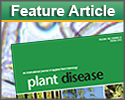 Identifying and Managing Root Rot of Pulses on the Northern Great Plains
Identifying and Managing Root Rot of Pulses on the Northern Great Plains
View Article
Pulse crops are becoming more widespread and economically significant in the northern Great Plains of North America, and in many areas, increases in root rot diseases have caused reduced stand establishments and yields. Gossen et al. describe the important pathogens involved in the root rot complex and summarize current management practices on pulse crops in this region.
September 2016
Leguminous Green Manure Incorporation and Fusarium Wilt Suppression in Watermelon
View Article
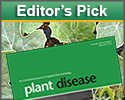 Himmelstein et al. investigate how changes in the soil environment caused by incorporating cover crops suppress Fusarium wilt of watermelon. Specifically, increases in soil respiration following incorporation of legume cover crops suggest increases in overall soil microbial activity and consequently general suppression of Fusarium oxysporum f. sp. niveum. However, lab and greenhouse studies indicate that specific suppression may also play a role.
Himmelstein et al. investigate how changes in the soil environment caused by incorporating cover crops suppress Fusarium wilt of watermelon. Specifically, increases in soil respiration following incorporation of legume cover crops suggest increases in overall soil microbial activity and consequently general suppression of Fusarium oxysporum f. sp. niveum. However, lab and greenhouse studies indicate that specific suppression may also play a role.
August 2016
Blueberry necrotic ring blotch virus in Southern Highbush Blueberry in U.S. Southeast
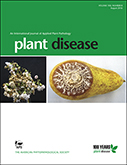 View Article
View Article
Blueberry necrotic ring blotch, caused by Blueberry necrotic ring blotch virus (BNRBV), is a new disease that has recently been observed on southern highbush blueberry (SHB) cultivars in the southeastern United States. Robinson et al. conducted experiments to determine how the virus spreads in the field. Their findings suggest that BNRBV does not infect SHB plants systemically, that it is not transmitted through vegetative propagation, and that it does not likely persist in plants after natural defoliation in the fall.
July 2016
 Timing of Glyphosate Applications to Wheat Cover Crops to Reduce Onion Stunting Caused by Rhizoctonia solani
Timing of Glyphosate Applications to Wheat Cover Crops to Reduce Onion Stunting Caused by Rhizoctonia solani
View Article
Cereal cover crops are used in agricultural production systems for a number of reasons, including to prevent wind erosion of soil. A cereal winter cover crop is planted in the fall and killed with an herbicide just before or after planting a cash crop. Soilborne pathogens, such as Rhizoctonia solani, are often more prevalent in crops planted soon after the cover crop is killed. Sharma-Poudyal et al. evaluated how the length of the interval between herbicide application and onion seeding affects onion stunting caused by R. solani. As the interval between herbicide application and onion planting increased, the number of patches of stunted onions decreased and the DNA concentration of R. solani in soil sampled from the dead cover crop declined. These data suggest that in fields with a high risk of onion stunt, cover crops should be terminated 3 weeks before onion seeding.
June 2016
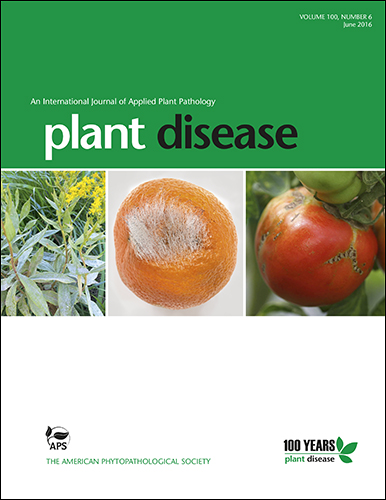 Patterns of Ergot and Quantification of Sclerotia in Perennial Ryegrass Seed Fields
Patterns of Ergot and Quantification of Sclerotia in Perennial Ryegrass Seed Fields
View Article
Ergot, caused by Claviceps purpurea, is the most important disease affecting perennial ryegrass seed production in eastern Oregon. The disease results in economic losses due to reduced yield, the cost of increased seed cleaning to remove sclerotia from seed lots, and the production of seed that cannot be sold as feed because of alkaloid contamination. Dung et al. quantify and describe the spatial pattern of ergot severity in commercial perennial ryegrass fields. Significant autocorrelation and clustering were indicated by Moran’s I and spatial analysis by distance indices of aggregation.
May 2016
Quantitative PCR System for Measuring Sclerotinia sclerotiorum in Canola
View Article
Sclerotinia stem rot, caused by
Sclerotinia sclerotiorum, is an economically important disease of many crops, including canola. Ziesman et al. report using a quantitative PCR system to reliably measure pathogen DNA in S. sclerotiorum-infested petals. Because petal infestation is an important stage in the disease cycle in canola, this assay has the potential for use in disease risk assessment.
April 2016
 Distribution of Agrobacterium vitis in Grapevines and Its Relevance to Pathogen Elimination
Distribution of Agrobacterium vitis in Grapevines and Its Relevance to Pathogen Elimination
View Article
Crown gall of grape, caused by Agrobacterium vitis, is an economically important disease, and propagation of disease-free material could provide a means of management by preventing infection of vines during their first years of growth. Johnson et al. used magnetic capture hybridization and real-time PCR to monitor A. vitis in grapevines. They report that the pathogen is distributed nonuniformly on dormant and green plant tissues and that it colonizes shoot meristems. Consequently, multifaceted strategies may be required to produce clean plants.
March 2016
Detection of Race 3 Biovar 2 (R3bv2) and Native U.S. Strains of Ralstonia solanacearum
View Article
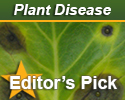 Tran et al. compare several published methods of detecting R3bv2 and native strains of R. solanacearum for sensitivity, speed, cost, and ease of use. Based on their data, the authors suggest a pipeline for screening geranium plants using strain-specific PCR on DNA immobilized on FTA cards. The authors also identify a reliable, sensitive, cost-effective assay to test for R3bv2 infection of field-grown tomato plants.
Tran et al. compare several published methods of detecting R3bv2 and native strains of R. solanacearum for sensitivity, speed, cost, and ease of use. Based on their data, the authors suggest a pipeline for screening geranium plants using strain-specific PCR on DNA immobilized on FTA cards. The authors also identify a reliable, sensitive, cost-effective assay to test for R3bv2 infection of field-grown tomato plants.
February 2016
Genetic Diversity and Biocontrol of Rosellinia necatrix Infecting Apple in Northern Italy
View Article
Rosellinia necatrix causes white root rot disease on many economically important plants, and because this fungus survives in soil for long periods, it is difficult to manage. To provide apple growers with management tactics, Pasini et al. assessed the genetic diversity of R. necatrix to determine potential sources of inoculum. They also evaluated soil water content and temperature as factors that influence infection, along with certain production practices and a biocontrol agent.
January 2016
Survival of Phytophthora infestans in Tomato Seed at Cold Temperatures
View Article
Using a cooling degree-day model, Frost et al. demonstrate that Phytophthora infestans, causal agent of potato and tomato late blight, can overwinter via asexual means in tomato seed in northern latitudes. Their data suggest that in the spring, volunteer seedlings can serve as a source of primary inoculum for late blight disease in northern regions.
Mark L. Gleason, Editor-in-Chief (2013 - 2015)
December 2015
The Effect of Delayed-dormant Chemical Treatments on DMI Sensitivity in a DMI-resistant Population of Ventura inaequalis
View Article
Frederick and colleagues report results of New York field trials in which several chemicals were applied to apple trees during the period between bud break and appearance of green leaf tissue. They found that a spraying a copper material at that time resulted in significant reduction of isolate growth on DMI (myclobutanil)-amended media, suggesting that such treatments could be used to help manage proliferation of DMI fungicide resistance in apple orchards.
November 2015
Barberry as an Alternate Host for Wheat Rust Pathogens
View Article
Wang and colleagues present evidence that in the U.S. Pacific Northwest, barberry is the alternate host of the wheat stem rust pathogen (Puccinia graminis f. sp. tritici) under natural conditions but not the wheat stripe rust pathogen (P. striiformis f. sp. tritici).
October 2015
Leaf Doctor: A New Portable Application for Quantifying Plant Disease Severity
View Article
Pethybridge and Nelson describe a new mobile app, available free from the iTunes Store, that streamlines the process of disease severity assessment. The app offers advantages of greater speed and accessibility over Assess, which is the current standard software for automated severity assessment. In their tests, Leaf Doctor performed well in assessing severity of foliar diseases of six different crops and commodities.
September 2015
Efficiencies of Plum pox virus eradication programs in Pennsylvania and Ontario
View Article
Gougherty and colleagues take the unusual path of evaluating how methodological differences between large-scale virus eradication programs carried out in two locations impacted the probability of detecting the virus in plum trees. Using a modeling approach, they determined that the efficiency of detection of plum pox virus was 72% in Pennsylvania vs. 41% in Ontario and pinpointed which components of the PPV eradication programs affected detection probability.
August 2015
 Fungicide Sensitivity of Botrytis cinerea
Fungicide Sensitivity of Botrytis cinerea
View Article
Applying site-specific fungicides is the primary strategy for controlling gray mold of strawberry in Germany. In the August issue, Grabke and Stammler report on resistance of the gray mold fungus, Botrytis cinerea, to multiple fungicides. They found a wide diversity of fungicide sensitivity among nearly 200 isolates obtained from strawberry fields on a single day. Although many isolates were sensitive to single fungicides, a substantial number were resistant to as many as six fungicides.
May 2015
Organic Mineral Seed Coating for Control of Seedling Diseases of Alfalfa
View Article
 Most alfalfa seed is coated with the fungicide mefenoxam to protect against seedling diseases caused by oomycetes. However, this treatment is ineffective against Aphanomyces euteiches and unacceptable for organic production. In the May issue, Samac and colleagues report on testing natural zeolite as a seed coating against both pathogen groups. In seed inoculation and infested soil trials in growth chambers, the zeolite coating provided significantly higher percentages of healthy seedlings than either mefenoxam or no treatment and did not affect in vitro growth of the nodule-forming bacterium Sinorhizobium meliloti. The authors conclude that zeolite has potential value as a seed coating for alfalfa.
Most alfalfa seed is coated with the fungicide mefenoxam to protect against seedling diseases caused by oomycetes. However, this treatment is ineffective against Aphanomyces euteiches and unacceptable for organic production. In the May issue, Samac and colleagues report on testing natural zeolite as a seed coating against both pathogen groups. In seed inoculation and infested soil trials in growth chambers, the zeolite coating provided significantly higher percentages of healthy seedlings than either mefenoxam or no treatment and did not affect in vitro growth of the nodule-forming bacterium Sinorhizobium meliloti. The authors conclude that zeolite has potential value as a seed coating for alfalfa.
April 2015
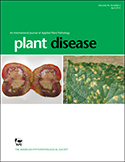 Heart Rot of Pomegranate
Heart Rot of Pomegranate
View Article
In the April issue, Ezra and colleagues pinpoint the fungus Alternaria alternata as the causal organism of heart rot, a major disease of pomegranate in Israel, and explain how it causes internal rot of fruit. The investigators isolated A. alternata from the pistils of more than 85% of open flowers and tracked its path through the style and into the lower loculus of the fruit, where it can remain as a latent infection for up to 4 months until ripening begins.
March 2015
Inhibition of the Butternut Canker Pathogen by a Bark Extract
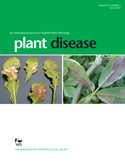 View Article
View Article
In the March issue, Moore and colleagues describe development of a new technique to identify butternut (Juglans cinerea) trees with resistance to butternut canker—a fatal disease that has wiped out most native butternut in North America. Levels of the biochemical juglone in bark correlated directly with the results of a bark extract assay for suppression of the fungal pathogen (Ophiognomonia clavigignenti-juglandacearum). This assay may prove useful in selecting resistant butternut for conservation and forest restoration.
February 2015
Influence of Open Alleys in Field Trials
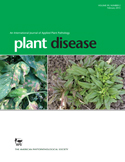 View Article
View Article
In the February issue, Vincelli and Lee tackle a seldom-addressed but important question in field studies of fungicide impact: Can plot design bias results? The authors tracked yield as a function of subplot position with and without application of Headline AMP (pyraclostrobin plus metconazole). Although some interaction between yield and subplot position was noted, the overall impact of subplot position on yield was negligible. Thus, the authors conclude that the open-alley design typical of many corn fungicide trials does not bias assessment of treatment effects.
January 2015
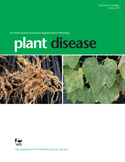 Forecasting of Rhizoctonia Web Blight Development on Azalea
Forecasting of Rhizoctonia Web Blight Development on Azalea
View Article
In the January issue, Warren Copes reports on a disease risk assessment model based on weather measurements from 11 site-year datasets. Using receiver operating characteristic (ROC) curve analysis, Copes identified a model that is a strong predictor of epidemic development on container-grown azalea. The model awaits field testing to validate its usefulness for controlling Rhizoctonia web blight, a key disease in the nursery industry.
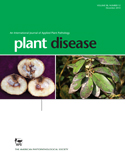 December 2014
December 2014
A Novel Plant Family-Specific Root Pathogen
View Article
In the December issue, Stanghellini and colleagues present evidence for a new species of Pythium with a host range that appears to be restricted to plants in the family Brassicaceae. The authors propose that the species formerly designated as P. jasmonium, which was never formally described, be renamed P. brassicum in recognition of the pathogen’s close association with the host family.
November 2014
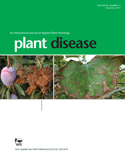 Fitness of Erysiphe necator Against Quinone Outside Inhibitors
Fitness of Erysiphe necator Against Quinone Outside Inhibitors
View Article
Rallos and colleagues report that strains of the grape powdery mildew pathogen (Erysiphe necator), isolated from Virginia and nearby states, that are resistant to quinone outside inhibitor (QoI) fungicides demonstrated fitness and persistence in mixed sensitive and resistant populations in the absence of QoI applications. This result suggests that QoI-resistant isolates will likely remain in vineyards even after use of these fungicides has been discontinued.
October 2014
A Latent Period Duration Model for Wheat Stem Rust
 View Article
View Article
In the October issue, Hernandez Nopsa and Pfender report on predicting duration of the period from infection initiation to pustule eruption by Puccinia graminis subsp. graminis, the causal agent of wheat stem rust. Experiments on wheat under controlled conditions found significant differences in latent period duration across a range of temperatures (5–33°C), and a mathematical model was developed to express the response pattern. Field experiments confirmed the predictive value of the model, which may help in estimating the rate of epidemic development.
September 2014
A Sheepish Way to Spread Disease
View Article
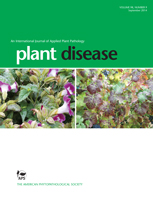 The September issue presents an unusual study carried out by Markakis and colleagues to determine the survival, persistence, and infection efficiency of Verticillium dahliae passed through the digestive tracts of sheep. In the study, which was conducted in Greece, the authors documented that when vegetable crops infected with V. dahliae were fed to sheep, the pathogen survived in the animals' digestive tracts up to 5 days. Interestingly, eggplant seedlings that were transplanted into composted manure from these sheep developed disease symptoms caused by V. dahliae—the first experimental evidence that sheep can function as a vector for dissemination of this important soilborne fungal pathogen.
The September issue presents an unusual study carried out by Markakis and colleagues to determine the survival, persistence, and infection efficiency of Verticillium dahliae passed through the digestive tracts of sheep. In the study, which was conducted in Greece, the authors documented that when vegetable crops infected with V. dahliae were fed to sheep, the pathogen survived in the animals' digestive tracts up to 5 days. Interestingly, eggplant seedlings that were transplanted into composted manure from these sheep developed disease symptoms caused by V. dahliae—the first experimental evidence that sheep can function as a vector for dissemination of this important soilborne fungal pathogen.
August 2014
Fungicide Resistance Profiles and Evidence for Stepwise Accumulation of Resistance in Botrytis cinerea
View Article
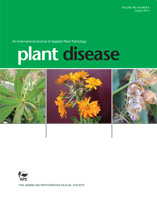 In the August issue, Li and colleagues present statistical evidence—based on assessment of resistance of several hundred isolates obtained in conventionally managed blackberry and strawberry fields in North and South Carolina—that Botrytis cinerea acquires resistance to different fungicide classes in a stepwise manner. Specifically, isolates resistant to thiophanate-methyl were more likely to acquire resistance to pyraclostrobin than to boscalid and to fenhexamid when compared with random chance. The authors make a strong case that multifungicide resistance to B. cinerea has evolved via a stepwise accumulation of single-fungicide resistances.
In the August issue, Li and colleagues present statistical evidence—based on assessment of resistance of several hundred isolates obtained in conventionally managed blackberry and strawberry fields in North and South Carolina—that Botrytis cinerea acquires resistance to different fungicide classes in a stepwise manner. Specifically, isolates resistant to thiophanate-methyl were more likely to acquire resistance to pyraclostrobin than to boscalid and to fenhexamid when compared with random chance. The authors make a strong case that multifungicide resistance to B. cinerea has evolved via a stepwise accumulation of single-fungicide resistances.
Spanish translation courtesy of Hayley M. Nelson, Iowa State University
En la edición agosto, Li y colegas presentan evidencia estadística—basado en evaluación de resistencia de varios cientos de aislados obtenidos en campos de zarzamora y fresa que fueron dirigidos de manera convencional en Carolina del Norte y Carolina del Sur—que Botrytis cinerea adquiere resistencia a diferentes clases de fungicidas en una manera constante. Específicamente, los aislados resistentes a thiophanate-methyl fueron mas probables adquirir resistencia a pyraclostrobin que boscalid y fenhexamid cuando comparado al azar. Los autores hacen un caso fuerte que la resistencia de amplio espectro a B. cinerea ha evolucionado por una constante acumulación de resistencias de fungicidas solas.
Chinese translation courtesy of Xiaoyu Zhang, Iowa State University
在八月的期刊上,Li及其同事报道了他们的统计分析结果—在对数百株来自北卡罗来纳州和南卡罗来纳州传统方式培育的黑莓和草莓上分离的灰霉菌进行分析后发现—这些菌株以逐步积累的方式对不同种类的农药产生了抗药性。他们特别地指出,相比于随机产生抗性的情况,对甲基硫菌灵具有抗药性的菌株容易对吡唑醚菌酯产生抗性,具有双重抗药性的菌株更易对啶酰菌胺和环酰菌胺类药物产生多种抗性。本文的作者们充分证明了灰霉菌的多种抗性是以逐步积累单一抗药性的方式产的。
July 2014
Evaluation of Atoxigenic Aspergillus flavus Strain AF36 in Pistachio Orchards
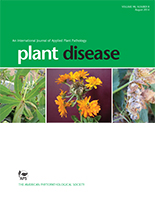 View Article
View Article
In the July issue, Doster and colleagues report success in altering the population balance of Aspergillus flavus in California pistachio orchards in favor of atoxigenic strain AF36 after applying AF36-infested grain to orchard floors. The researchers also report that this practice reduced the incidence of aflatoxin-contaminated nuts at harvest by 20–45% in treated orchards compared with untreated orchards. This reduction represents a meaningful advance in managing aflatoxin contamination, which is difficult to control.
Spanish translation courtesy of Hayley M. Nelson, Iowa State University
En la edición de junio, Doster y colegas reportan éxito alterando la balanza de la populación de Aspergillus flavus en los huertos de pistacho en California a favor de la cepa atoxigénica AF36 después de aplicar granos infestados con AF36 a los suelos de los huertos. Los investigadores también reportan que esta práctica redujo la incidencia de nueces contaminados con aflatóxinas a cosecha entre 20 por ciento y 45 por ciento en los huertos tratados comparado con los huertos no tratados. Esta reducción representa un avance significante en el manejo de contaminación de aflatóxinas, las cuales sean difíciles controlar.
Chinese translation courtesy of Xiaoyu Zhang, Iowa State University
在七月的刊物中,Doster及其同事报道了他们应用在果园地面放置带有无毒黄曲霉菌株AF36谷粒的方法成功地改变了加州开心果果园中黄曲霉菌种群的平衡的研究。研究人员同时报道应用该方法的果园相比于对照果园在收获时开心果的黄曲霉毒素感染率减少了20%-45%。这一研究结果表明此方法在控制黄曲霉毒素感染这一难题上取得了重要的进展。
June 2014
Cassava Frogskin Disease in Brazil
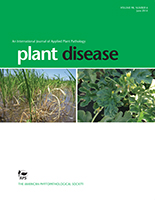 View Article
View Article
In the June issue, de Souza and colleagues report progress in identifying the causal agent or agents of cassava frogskin disease (CFSD), a devastating disease of this major food crop in tropical regions of the world. By analyzing DNA extracts from symptomatic and asymptomatic plants using PCR, RFLP, and sequencing, the authors identified a phytoplasma belonging to group 16SrIII-A—the first report of this group associated with cassava. The authors also identified a dsRNA virus that may co-infect cassava plants with CFSD symptoms.
Spanish translation courtesy of Hayley M. Nelson, Iowa State University
En la edición de junio, de Souza y colegas reportan progreso con la identificación del agente causal o los agentes del Cuero de Sapo de la yuca (CFSD), una enfermedad devastadora de este principal cultivo en regiones tropicales del mundo. Mediante el análisis de extractos de ADN de plantas sintomáticas y asintomáticas usando la reacción en cadena de la polimerasa (PCR), los polimorfismos de longitud en fragmentos de restricción (RFLP), y sequenciando, los autores identificaron una fitoplasma la cual pertenece al grupo 16SrIII-A—el primer reporte de este grupo asociado con yuca. Los autores también identificaron un virus de ARNcd que podría coinfectar las plantas de yuca con síntomas de CFSD.
Chinese translation courtesy of Xiaoyu Zhang, Iowa State University
在今年六月的期刊上, de Souza及其同事报道了鉴定木薯蛙皮病 (cassava frogskin disease CFSD)病原的进展。这是一种对全球热带地区的主要粮食作物有巨大威胁的病害。作者将有此症状和无此症状植物样本的DNA 进行PCR, RFLP以及序列分析后,鉴定其病原为16SrIII-A组植原体—这是首次在木薯上发现这一组植原体。作者同时发现一种双链RNA病毒有可能和木薯蛙皮病的病原协同侵染木薯。
May 2014
Triazole Sensitivity in Fusarium graminearum from New York Wheat
View Article
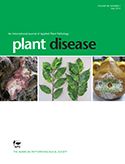 In an article in the May issue, Spolti and colleagues describe the discovery in New York of the first tebuconazole-resistant field isolate of Fusarium graminearum reported in the Americas. The isolate was found to have the lowest sensitivity to tebuconazole ever documented for this pathogen, which causes Fusarium head blight (FHB). Following the application of tebuconazole, wheat plants inoculated with this isolate had more severe FHB and higher concentrations of the mycotoxin deoxynivalenol (DON) than plants inoculated with a tebuconazole-sensitive isolate. Moreover, preliminary assessments indicated that the resistant isolate was more competitive in these experiments.
In an article in the May issue, Spolti and colleagues describe the discovery in New York of the first tebuconazole-resistant field isolate of Fusarium graminearum reported in the Americas. The isolate was found to have the lowest sensitivity to tebuconazole ever documented for this pathogen, which causes Fusarium head blight (FHB). Following the application of tebuconazole, wheat plants inoculated with this isolate had more severe FHB and higher concentrations of the mycotoxin deoxynivalenol (DON) than plants inoculated with a tebuconazole-sensitive isolate. Moreover, preliminary assessments indicated that the resistant isolate was more competitive in these experiments.
Spanish translation courtesy of Hayley M. Nelson and Erika Saalau Rojas, Iowa State University
En “Sensibilidad de Triazole en Una Población Contemporánea de Fusarium graminearum en Trigo de Nueva York y la Competitividad de Un Aislamiento Resistente a Tebuconazole,” Spolti y colegas describen el descubrimiento en Nueva York del primer aislamiento de campo de Fusarium graminearum reportado en las Américas resistente a tebuconazole. El aislamiento presentó la mas baja sensibilidad a tebuconazole antes documentada para este patógeno, el agente causal de Fusarium head blight (FHB). Seguida la aplicación de tebuconazole, las plantas de trigo inoculadas con el aislamiento exhibieron/presentaron FHB más severa y concentraciones más altas de la micotoxina deoxynivalenol (DON) que en las plantas inoculadas con un aislamiento sensible a tebuconazole. Las evaluaciones preliminares indicaron que el aislamiento resistente a tebuconazole fue más competitivo en estos experimentos.
Chinese translation courtesy of Xiaoyu Zhang, Iowa State University
在“纽约地区小麦禾谷镰刀菌目前流行群体对三唑类杀菌剂的敏感性研究以及戊唑醇抗性菌株与野生菌株的竞争实验” 这篇文章中,Spolti及其同事描述了在纽约发现的美洲第一株田间分离的具有戊唑醇抗性的禾谷镰刀菌。该菌株是有记载以来引起小麦赤霉病的菌株中对戊唑醇杀菌剂敏感性最低的。在接下来的实验中,接种此抗性菌株的小麦比接种另一株高敏感性菌株的小麦在戊唑醇处理后表现出更严重的赤霉病症状并且含有更多真菌毒素脱氧雪腐镰刀菌烯醇(DON)。并且初步的实验证据表明此戊唑醇抗性菌株较之于敏感菌株在田间更具竞争优势。
April 2014
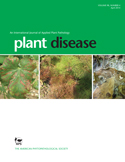 Xylella fastidiosa and Bacterial Leaf Scorch
Xylella fastidiosa and Bacterial Leaf Scorch
View Article
Bacterial leaf scorch of blueberry, caused by Xylella fastidiosa, is a recently recognized disease of southern highbush blueberry in the southeastern United States. In the April issue of Plant Disease, Holland and colleagues report on the potential value of pruning for disease management—namely, by sampling various plant parts for the presence and titer of the pathogen in naturally infected plants displaying various levels of symptom severity. Using real-time PCR with specific primers, the researchers found that X. fastidiosa was consistently present in the sap of stem samples in the middle and basal portions of plants even at low symptom severity levels and in the roots at moderate to high symptom severity levels. They concluded that pruning was unlikely to be helpful in curing plants infected with the disease.
March 2014

Disease-Suppressive Vermicompost
View Article
In the March issue of Phytopathology, Carr and Nelson assess how extracts of vermicompost affect the soilborne pathogen Pythium aphanidermatum. Using time-lapse photomicroscopy to monitor the responses of mature zoosporangia, the researchers found that both sterile and nonsterile vermicompost extracts inhibit indirect germination and production of zoospores; however, zoospores are able to germinate directly by producing germ tubes in the compost extracts. In bioassays, the compost extracts did not suppress germ tube growth or infection of cucumber seed. Carr and Nelson conclude that composts may be able to affect multiple stages of P. aphanidermatum development, perhaps by both microbial and nonmicrobial means.
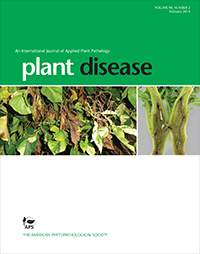 February 2014
February 2014
Seedling Resistance to Sclerotinia sclerotiorum
View Article
In the February issue of Plant Disease, Uloth and colleagues report differences in seedling resistance to Sclerotinia sclerotiorum based on an assay of 46 lines from 12 species of cruciferous crops and weeds. Lines of cabbage and broccoli were most resistant, whereas lines of various wild radish and mustard species were most susceptible. This article is the first to report high levels of resistance to this important soilborne pathogen in Brassica oleracea (cabbage and broccoli) at the cotyledon stage.
 January 2014
January 2014
Control of Phytophthora nicotianae
View Article
In the January issue, Morales-Rodríguez and colleagues report on their examination of a set of isolates of Phytophthora nicotianae from tomato and pepper plants in southwestern Spain. Mefenoxam sensitivity was greater in the pepper isolates than in the tomato isolates, and inhibition of the pathogen by biofumigants was dosage dependent. A commercial form of pelletized Brassica was effective in suppressing the pathogen in greenhouse trials using pepper plants. The authors anticipate that Brassicaceae tissues can supplement mefenoxam in an integrated disease management program to forestall development of resistance to the fungicide.
